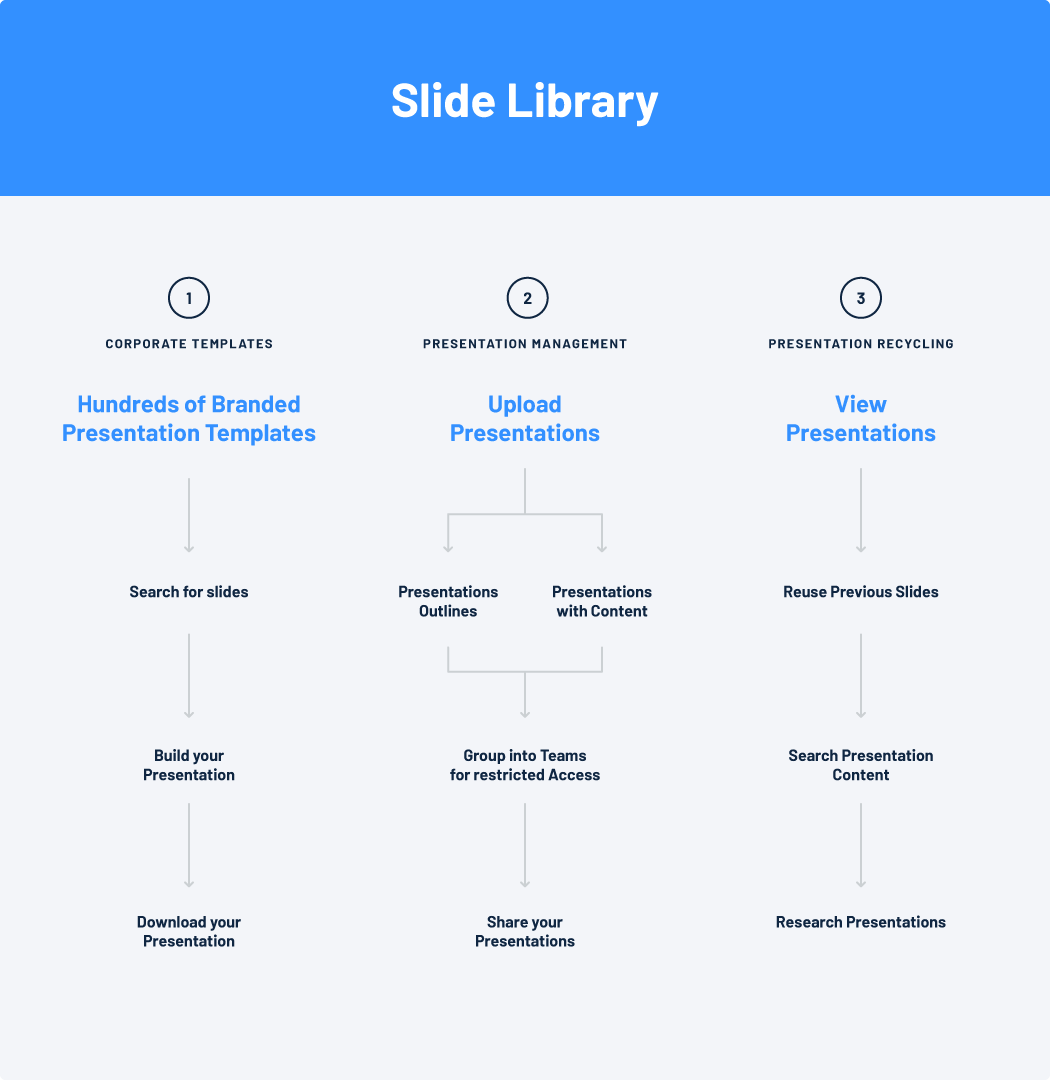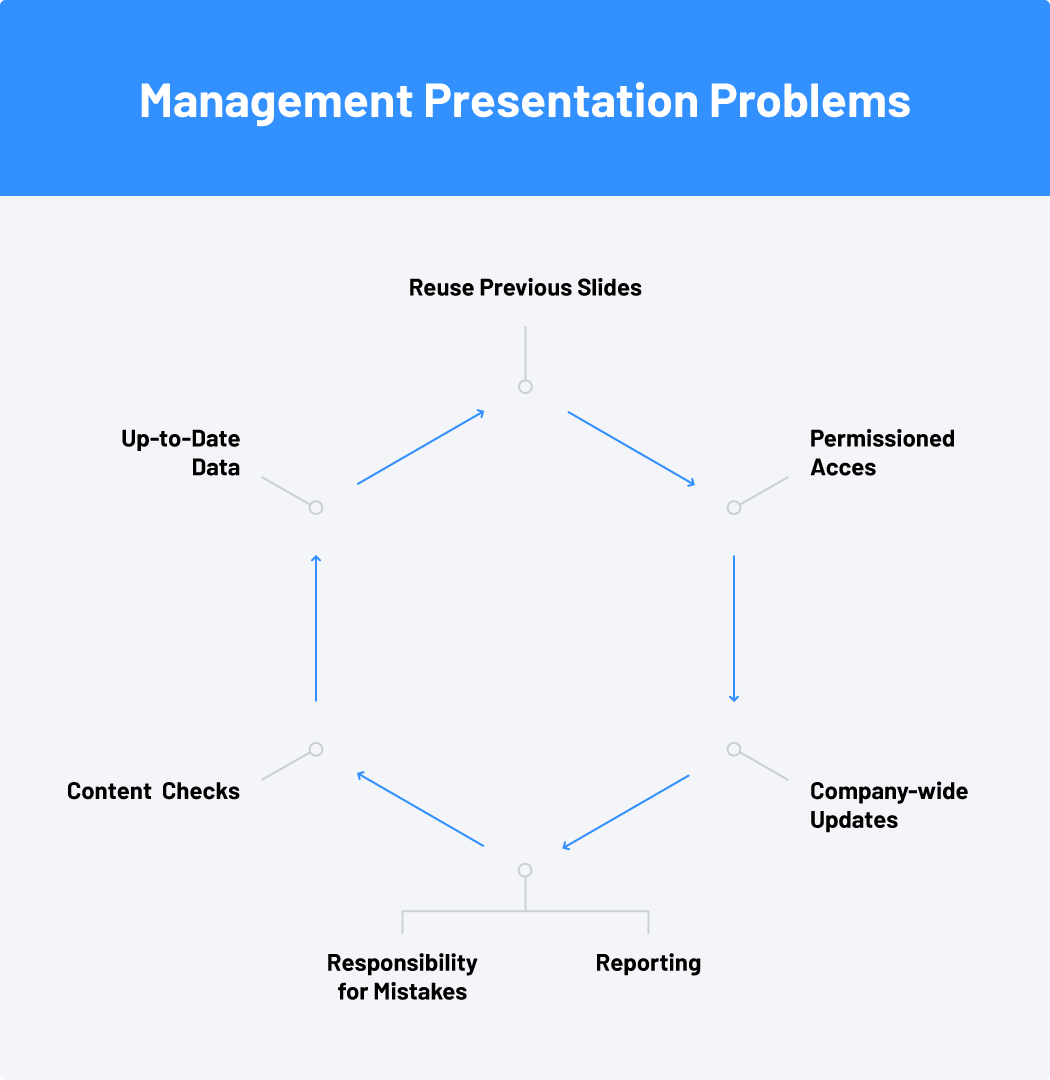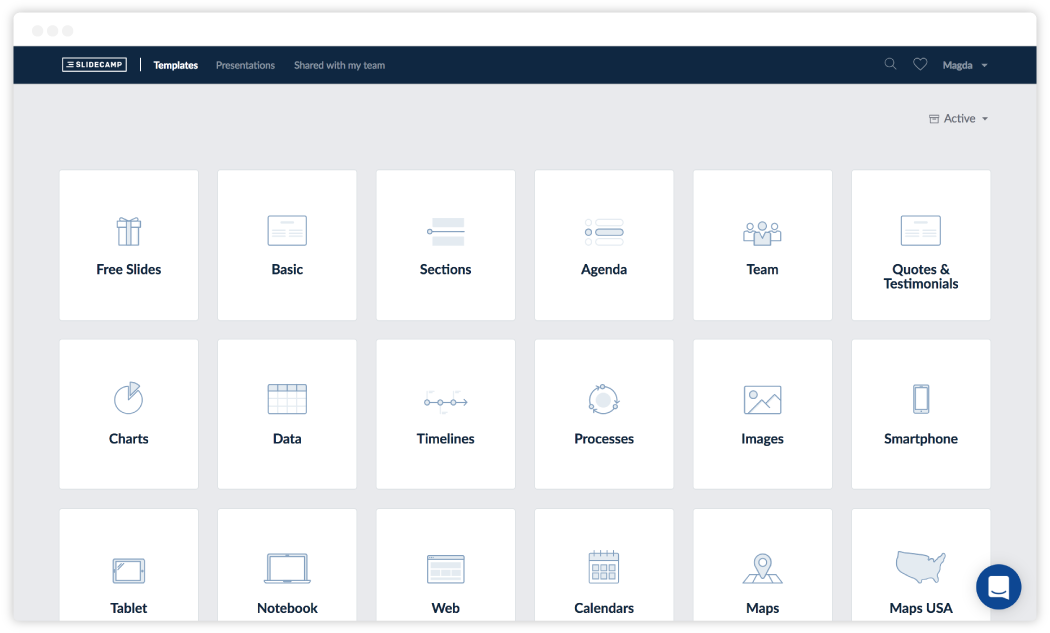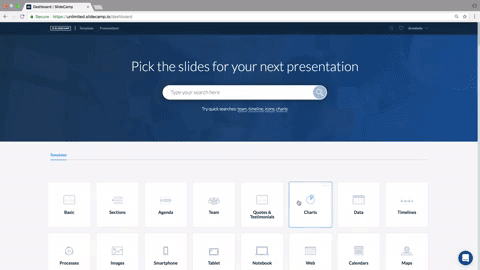If we asked you to come up with a list of all the presentation problems you’ve seen as a manager, we’d both be here all week. From last minute corrupted files to the company logo from last year, you’ve probably felt the stress of it all whilst wondering why this problem seems to be infallible against change.
Business does not want PowerPoint to die. It’s predictable, and stops showmanship getting in the way of bad content. It never fails to show the ugly truth, and it doesn’t dazzle you with impressive results and in the corporate world that’s a pretty valuable card to hold.
So besides hauling your whole company on to a CMS presentation tool, what other organizational options do you have as a manager to make PowerPoint work?
Well, you could implement a strict presentation upload point, and wait for the mess to start. Or you could just cut to the chase and start using a slide library to manage your presentations for you.
How Does a Slide Library Work?

Source: https://www.slidecamp.io/
A slide library, or (slidelibrary) is a collection of individual slide templates, organized in a way which makes it fast and effective to build quality presentations.
They’re usually adapted to company specifications. Meaning that every employee has access to hundreds of ppt charts, graphs, and other types of slides. All with the correct company presentation logos, color schemes, and fonts.
With a slide library there are three main areas in which it can solve management PowerPoint presentation problems:
1. Location, Location, Location
If your team do not currently keep presentations organized, you may not realize what a blessing keeping presentations in one place can be.
It’s not only a great way to save space on your team’s computers, but also creates a research base. Somewhere for future presenters to hunt for the information they need.
It can also be used to ensure presentation content quality is high. Allowing employees to check small details of presentations without having to send a waterfall of unanswered emails.
But best of all, keeping all your presentations in one place allows you to reuse slides in the future. With our slidelibrary, you can even search for content within presentations.
2. Easy as ABC
Keeping things easy in the office can be a daunting task. Between managing teamwork and ensuring everyone is giving it their all, achieving simplicity can seem impossible. But with presentations, it really doesn’t need to be that hard.
Using a slide organizer will naturally make using company templates easier than any other way to make a presentation.
Any other important elements to presentations can also be found in your company slides library. Enabling employees to get on with creating a compliant presentation without having spoken to the whole office.
3. Share the Load (Frodo)
Ever had to hunt down a particular slide? Sending out some random emails to who you think may hold the file, followed up with radio silence until after you’ve actually finished the presentation is frustrating.
So frustrating in fact, that most employees would just rather research things quickly, and go along with subpar information.
But this whole circle doesn’t need to appear when a slide library is in use. With every employee uploading their presentations, perhaps for approval, or perhaps after the presentation for later team research, the entire team can simply reuse slides which have already been created.
This is especially useful for sales figures, quarterly updates, or project reporting. And ensures compliance, correct information, and saves time on finalizing a presentation.
What Problems Does a Slide Library Solve for Management

Source: https://www.slidecamp.io/
It is management who are saddled with the burden of responsibility when issues such as non-compliance, leaks, or out of date data use come up.
Attempting to resolve each of these occurrences individually can be a nightmare. But our slidelibrary has been built to ensure management can sleep easy when it comes to presentations in the workplace. And even get the credit they deserve when reporting on their teams progress.
1. Presentation Management: Non-Compliance
Employees sending out the wrong message is usually seen as harmless human error. But it can turn more serious when consumers and clients notice, or when watchdogs and regulators become involved.
For management this may seem unavoidable, as mistakes will be made no matter what you do. Yet, with a presentation management strategy a.k.a. a slidelibrary, your old blanket acceptance of compliance mistakes will become absurd.
Using a slide library allows your legal team to ensure the wording used in presentations is already in the templates. Whilst also enabling your marketing team to ensure that a company wide message is in all the presentations across the company.
2. Presentation Management: Permissioned Access
Confidentiality leaks are always a nightmare for management. Whether that results in a legal dispute or repetitional damage. Confidentiality of presentations should be important in any team.
With the SlideCamp slidelibrary, managers can easily set up teams to ensure the right presentations are seen by the right people at the right time.
3. Presentation Management: Company-wide Updates
Business is versatile and ever changing. But never more so are mistakes made by employees than after they return from time off. Whether that’s maternity leave, annual leave, or just going home for the holidays. Every day spent away from the office means they’ve missed out on changes in the company.
Using a presentation platform means that changes are applied company wide to all templates instantly. This goes for figures, legal disclosures, staff changes and anything else which may crop up.
4. Presentation Management: Reporting
Reporting on the progress of your team can often be a daunting task when it comes to looking for evidence. Having to chase up team members to receive individual slides, or snippets of information isn’t anyone’s idea of a good time.
Yet, when using a slide library, you can access your whole teams presentations at a moments notice. Leaving reporting to become a much easier task in every step from the planning to execution.
5. Presentation Management: Responsibility
No matter the scale of a slip up. Whether that be a simple spelling error or completely missing the point of a new initiative, slidelibraries allow management to quickly view PowerPoint online. Getting to the of problems fast by tracking who presented what and when.
This can be especially useful when regarding interdepartmental management, during management changes, or when settling disputes between colleagues.
6. Presentation Management: Content Checks
A company presentation is usually given without having to go through a content check. But, there are important presentations which need to be given the go ahead by various departments. It’s vital these presentations contain the right data, legal statements, and design. But getting every department to sign off on the final version can be very complicated.
With a presentation management tool however, presentations can be uploaded and viewed by many departments online. When the presenter makes changes or replaces the file with an updated version, it also eliminates the risk of multiple PowerPoint versions floating around.
7. Presentation Management: Keep Data Up to Date
In a busy work environment, it’s very hard for management to keep employees motivated and up to speed with all the latest changes in the company. This is especially important for missed internal meetings, and in external presentations.
With a slide library, keeping everyone up to date becomes simpler. Any changes made to design, data, or wording can be updated directly in the slide library, without the need to worry if old data will be used.
How to Implement a Slide Library in Your Team

Source: https://www.slidecamp.io/
Implementing yet another new tool in your team’s toolbox can cause some serious grief. From learning new tech, to discovering tools aren’t compatible with each other, taking on a new tool these days takes some serious guts.
But with a slide library, there is no new fancy tech to learn. With simplicity and minimalist design at heart, there is no training, or even team meeting needed to figure out how it works.
But for managers, becoming the head of your company presentation account means you’ve got a few decisions to make before getting everyone on board.
Step by Step Guide to Slide Libraries
Step 1 – Branding Decisions
Before setting up your slide library, you need to decide how important branding is in your company presentations. With SlideCamp, there are three patterns we see from our clients:

Source: https://www.slidecamp.io/
Option 1: Branding is very important. I want my current template, logo, font, and colors put on every template in the slide library.
Option 2: Branding is important, but we could do with some redesign. Send us your brand specifications, and we’ll design a slide library tailored to your needs.
Option 3: Branding isn’t important. I want to get started with a slide library right away.
Step 2 – Get in Touch with Us
The SlideCamp pricing model varies depending on the size of your team. The more users you add, the cheaper the cost is per account.

Source: https://www.slidecamp.io/
If you would like to try SlideCamp before you purchase a team plan, we offer a no-commitment presentation free trial period for you to make a decision. All of our plans are on a rolling monthly basis with no fixed term, with the ability to unsubscribe anytime at all.
This is also the time to ask us for a quick free presentation template redesign if you require one.
Step 3 – Invite your Team
Once your account is set up, you can start to invite people via email to join your account.

Source: https://www.slidecamp.io/
Once they click on the email link, you can set up teams which will manage permission settings.
Step 4 – Creating Presentations
As soon as a team member has a SlideCamp account, they can start creating their very own presentation templates right away from scratch.

Source: https://www.slidecamp.io/
Simply browse through our collection, add the slides to your shelf, and download straight into PowerPoint.
Once downloaded, just replace our text, data, and highlighted geographical locations with your own either in PowerPoint, or in the linked excel spreadsheet.
Step 5 – Uploading Presentations
Uploading PowerPoint presentations in SlideCamp is simple.

Source: https://www.slidecamp.io/
Just click ‘Presentations’ at the top of your screen, and upload your presentation.
Don’t forget to add a title, tags which could be useful when searching for this presentation in the future, and decide who should have access to this presentation.
Step 6 – View Presentations
View presentations uploaded by you and your team in SlideCamp without opening PowerPoint.

Source: https://www.slidecamp.io/
You can choose between viewing all the individual slides instantly, or playing the presentation in our online ppt viewer.
Step 7 – Update Presentations
Many account managers choose to upload two types of presentations:
Presentation outlines, which show in what order a presentation should be made, but does not hold much if any content.
Finished presentations, which have content and information included.

Source: https://www.slidecamp.io/
Presentation outlines can be particularly useful. Instantly downloaded by team members when giving an update, or other regularly made presentations.
To update a presentation outline, simply download the presentation, make the updated changes, and upload the new presentation. Be mindful to delete the old version, and content errors will be avoided.
Step 8 – Search PowerPoint Slides
Searching the content of previously uploaded PowerPoint slides can be done from the homepage.

Source: https://www.slidecamp.io/
Enter a phrase, name, or just a single word in the main search box, and SlideCamp will show you all the individual slides related to your query.
Step 9 – Present Easy
Continue to use SlideCamp to make presentations, and to upload PowerPoint files and templates.
If you have any questions, comment, or queries, you can always chat to us directly by using the bubble in the corner of your screen.
Essentially, implementing a slidelibrary to your management strategy can be means tested for free with minimal setting up, and no upfront costs.
How to Measure Success Using A Slide Library

Source: https://www.slidecamp.io/
Proving why your strategies are useful, and documenting your team’s successes is a big part of every manager’s job.
Which means playing around with various management tools results in hauling your whole team on board. And convincing them all to use a new tool efficiently can be hard work. Our slidelibrary has been created with one constant in mind: Make the Presentation Process Simple. Less effort to get presentations done means less time drafting emails, less time lost searching for information, and less time spent in PowerPoint. Which all equates to more time spent on actual projects at hand.
What employee wouldn’t want to finish up early? And what manager wouldn’t be impressed when they finish ahead of schedule?
How to Measure : Time Saving with a Slide Library
According to the IDC, over 45% of information workers are frustrated working with documents. As one of the most meaty attachments sent on a regular basis, PowerPoint files take up a large part of that frustration on a regular basis.
In addition to the frustration that employees experience, it ultimately results in diminished productiveness.
Using a presentation management system cuts out the process of sending presentations via email. Making it easy for different parties to simultaneously see the current document version on the SlideCamp platform.
We recommend creating an anonymous survey in your team on how long they spend completing the following tasks. It should be completed once before using a slidelibrary, in addition to after implementing a slidelibrary in your team:
- How much time do you spend researching before giving a presentation?
- Do you contact others for information needed in your presentation? If so, how many people do you contact on average?
- How long do you spend creating a PowerPoint file (including design, template use, graphs, and further editing)
- How long does it take to get approval from all interested parties on your finished presentation?
- On average, how much time does it take to complete a presentation with all the previous steps involved?
Using these, or similar questions in your team will enable you to report on the time saving total of implementing a presentation management system. It will be a concrete statistic when calculating your own slidelibrary ROI.
How to Measure: Productivity Increases with a Slide Library
Ultimately, any measure of productivity is only accurate if measured appropriately. In every team that will require something slightly different.
In a sales department, the productivity increase will undoubtedly be measured in performance. However when implementing a slidelibrary to a department which is more inward focused, such as in accounting teams, productivity may become a little trickier to measure.
The Harvard Business Review wrote an esteemed article way back in 1988, only a year after PowerPoint first kicked off. It old us how to measure productivity effectively and in a way which provides value depending on your department, and your industry.
They value a multifactor perspective. Although this requires more management effort, it will result in an accurate measure of productivity changes in your team.
How to Measure: ROI on your Slide Library
It’s likely measuring ROI on any new addition to your corporate repertoire is done in a particular way in your business.
But perhaps you do have some freedom with measuring the ROI of presentation management. If so here are a few factors you could quantify to get an accurate figure of the benefits of presentation management.
- Increased sales.
- Expanded product/service deployment.
- Greater return from other IT investments (e.g., ERP, portal).
- Accelerated time to market.
- Process efficiencies.
- Reduced Web production costs.
- Savings on paper/mailing costs.
- Reduced human errors.
Conclusion
All in all, using a slide library gets your team moving moving faster. It creates an office environment where information for more than just presentations can be found fast. If you need to show a new employee the sustainability policy, or a potential client you’re GDPR compliant quickly, a presentation management system will be a lifesaver.


